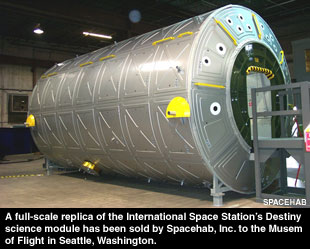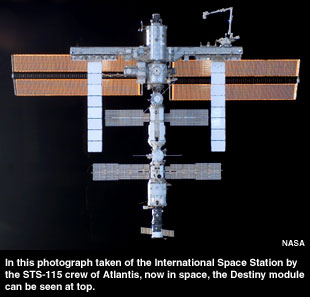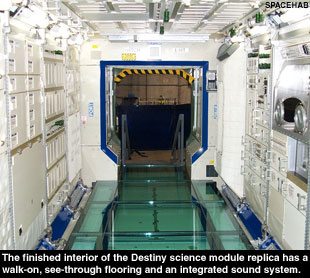|
|

|
Spacehab's mock module sold to Seattle

September 13, 2006 — Despite their name, the Museum of Flight in Seattle, Washington cannot fly all its visitors to the International Space Station. Thus, they've decided to do the next best thing: bring the outpost to the guests.
In a deal announced today, the museum has purchased a full-scale, high-fidelity replica of the station's U.S. Destiny laboratory from Spacehab, Inc., a government contractor best known for providing shuttle cargo modules to NASA.
"We are delighted that we have been able to procure this exemplary exhibit from Spacehab," Dr. Bonnie Dunbar, a five-time retired astronaut and President of the Museum of Flight, said in a press statement. "The Destiny exhibit will be our cornerstone piece for expanding our aerospace displays."
The museum is one of the largest in the world dedicated to air and space artifacts with more 150 air- and space- craft, including an SR-71 Blackbird spy plane, a Concorde supersonic passenger jet and the first Air Force One.
The Spacehab-built replica mimics the real module, which was built by The Boeing Company and launched on-board space shuttle Atlantis in 2001.

Like its on-orbit twin, the one-of-a-kind mockup measures approximately 28 feet long and 14 feet in diameter. It is outfitted with the same facilities as are located 220 miles above Earth, including an astronaut rest cabin, treadmill, experiment chamber ("glove box"), and storage cabinets.
Where the Spacehab creation differs from Destiny is in its added features, which were designed to provide museum visitors with both internal and external sights and sounds.
While both versions of the lab have a 20-inch window, the replica's is augmented by a flat panel display with Earth views. The mockup also has an integrated audio system.
Destiny was designed for zero-gravity and as such uses all four walls as workspaces. To compensate, Spacehab built their module with a walk-on, see-through floor so that visitors 'float' above the fourth wall.
Weighing more than 20,000 pounds, Spacehab's Destiny breaks apart into five sections for crated shipping. The Museum of Flight is expecting its delivery by the end of October and then will take several months for assembly.
According to Spacehab, the museum is planning special events and a gala to kickoff the exhibit by spring of 2007.

Spacehab originally built the replica several years ago at the request of a museum in Japan. When the funding fell through, the Houston-based company listed the lab on its subsidiary's website, The Space Store for $1.65 million.
When the online advertisement failed to attract a buyer, Spacehab turned to the museum community.
"We looked at a variety of museums that we felt could benefit from this," Kimberly Campbell, Spacehab's Vice President for Corporate Marketing and Communications, told collectSPACE. "We went to [the Museum of Flight] and they said 'Absolutely, this is a great addition.' Most museums need to go through a series of [meetings] with their founders and boards to determine how they're going to fund new exhibits, so that process took a little time."
While the exact price has not been released, the Museum of Flight did not pay the full price as was promoted online.
"If you were to ask us to build one just like, it would be closer to, or a little above the million dollar price tag but that is not what we sold it for," said Campbell. "But when you add up what we sold it for and some of the original funding that we received [from the Japanese museum] it is still close to that amount."
This is not the first replica Spacehab has built of Destiny, but it is the most detailed.
"We have a lot of experience building mockups in the past for NASA for the [Johnson Space Center's] Neutral Buoyancy Lab and Building 9 mockup facility," said Campbell of the agency's astronaut training facilities. "The one we built [for the museum], although modified to have tourists continually walking through it, has a lot more [detail] to it than I believe you will find in Building 9's [mockup]."
The actual Destiny module is the primary research lab for U.S. experiments aboard the station. Unlike artifacts from previous spaceflight missions, which have served second lives as popular museum exhibits, Destiny (and the other station modules) will never return intact to earth for future displays. |

© 2023 collectSPACE.com All rights reserved.
Questions? E-mail contact@collectspace.com

|
|

|

|
